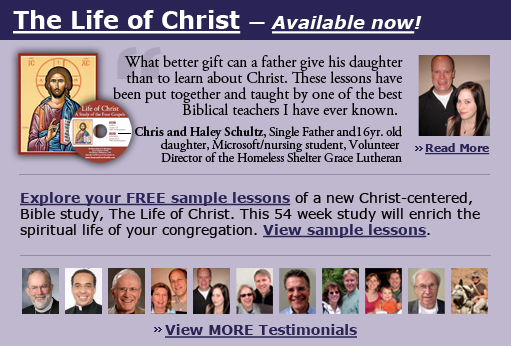
Series B
The Passion Story - Gospel Analysis
Part 2 Gethsemane
Mark 14:32-53
The following Bible study is from a larger course entitled, THE LIFE OF CHRIST: A Study in the Four Gospels. This 54 week course for the laity will be available for congregations in 2006.
Basic text for the course: SYNOPSIS OF THE FOUR GOSPELS, Kurt Aland, English Edition, P. 276-324
#330. Gethsemane
Matthew 26:36-46, Mark 14:32-42, Luke 22;39-46, John 18:1
-They went to a place called Gethsemane. The word, “Gethsemane” means “garden press.” The Gospel of John mentioned “across the Kidron valley.” The Kidron valley was “winter flowing valley.” It flowed only in the winter or rainy season. (Brown, V. 2, p. 806.)
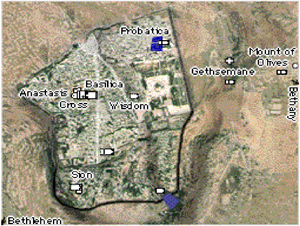
http://www.bibleplaces.com/mtolives.htm
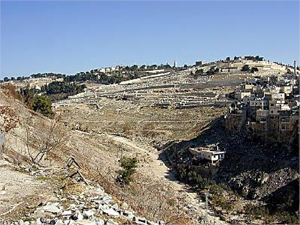
Today there is a cemetery on the hillside at the ancient Mount of Olives. We remember that Jesus ascended into heaven from the Mount of Olives (Acts 1:9-12) It seems fitting that there is a cemetery on the location from which Jesus ascended into heaven. We can see the Kidron Valley located at the base of the Mount of Olives. The Garden of Gethsemane was on the Mount of Olives.
http://www.ctsp.co.il/LBS%20pages/LBS_mt_of_olives.htm
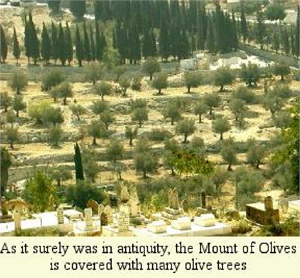
“One may combine the gospel information and think of the site as an olive grove on the lower slopes of the Mount of Olives, just across the Kidron valley from Jerusalem; and this is where Christian tradition has localized the site since the fourth century.” (Brown, JOHN, V. 2, p. 807.)
-And he said to his disciples, ‘Sit here while I pray.’ Jesus was a person of prayer. We too need to learn to pray like Jesus.
-He took with him Peter and James and John, Once again, we find the “big three” disciples who were with Jesus on the Mount of Transfiguration.
-And began to be distressed and agitated. We see and experience Jesus’ full humanity, which we also saw when Jesus wept at the death of his good friend, Lazarus. Some scholars think that Jesus should have been “above” such human feelings as distress, agitation and grief. They think that Jesus should have been more “Socratic” and accepted his coming death more magnanimously. In this moment, we see the full humanity of Christ. The movie, THE PASSION, was very good at recreating this scene of Jesus’ deepest agony.
-And said to them, ‘I am deeply grieved, even to death; remain here, and keep awake.’ We remember how Jesus deeply grieved the loss of his good friend, Lazarus.
-And going a little farther, he threw himself on the ground and prayed that, if it were possible, the hour might pass from him. We, too, are like Jesus. That is, we want God to remove this hour of intense suffering from our lives. The movie, THE PASSION, portrayed this deep emotional angst of Jesus.
-He said, ‘Abba, Father, for you all things are possible; remove this cup from me; yet, not what I want, but what you want.’ For us, this is at the heart of the Gethsemane story. That is, we know that God can do all things and that all things are possible for God. In the midst of our suffering or the suffering of others, we pray to God to eliminate our cup of suffering. But then … we move to deeper level in our soul. We then wisely pray to accept God’s will for our lives, even if God’s will isn’t our own will. The Spirit of Christ works in our hearts and we finally honestly confess: “I accept your will and your destiny for my life.” Jesus then becomes a symbol of us accepting our painful destiny. This happens to all of us at different times in our lives.
-He came and found them sleeping; and he said to Peter, ‘Simon, are you asleep? Could you not keep awake one hour? We, the Church, are keenly aware of the enormous and indescribable suffering of the world around us, and we can still fall asleep when all this tragedy surrounds our lives. We know that we are like Peter and sleep while the world around us is in misery. When Jesus is suffering within the bodies of the hungry and homeless around us, we fall asleep.
-Keep awake and pray that you may not come into the time of trial; Instead of the “time of temptation,” newer translations of the Bible translate the Greek phrase as “time of testing.” That is, God does not tempt any of us or lead us into temptation, but life itself is full of trials that challenge us. Life is also full of temptations for us to fall asleep in the facing of human suffering.
It is our deepest prayer that we or our loves ones will not face a time of intensive suffering.
-The spirit indeed is willing, but the flesh is weak.’ We human beings know how true this is. We have persistently willing spirits and willing words, but our human flesh, mind and habits persistently buckle and reveal how weak we are. Underline this sentence.
-And again he went away and prayed, saying the same words. 40And once more he came and found them sleeping, for their eyes were very heavy; and they did not know what to say to him. The disciples did not know what to say to Jesus when he found them asleep. We contemporary disciples are in the same situation.
-He came a third time and said to them, ‘Are you still sleeping and taking your rest? Enough! The hour has come; the Son of Man is betrayed into the hands of sinners. Get up, let us be going. See, my betrayer is at hand.’ Yes, the Church is still sleeping in the face of suffering. The hour of Jesus’ destiny has arrived. That is, the Son of Man is betrayed and “the end” is beginning to accelerate. The final chapter of Jesus’ life on earth has begun.
PAINTING AND IMAGINATION: GARDEN OF GETHSEMANE
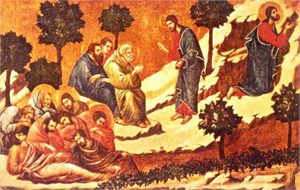
Durer
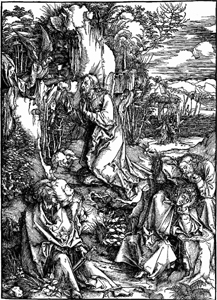
STAINED GLASS, NEW HAVEN, EVANGELICAL LUTHERAN CHURCH
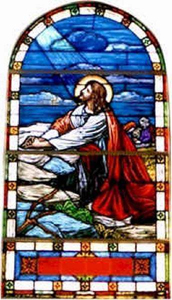
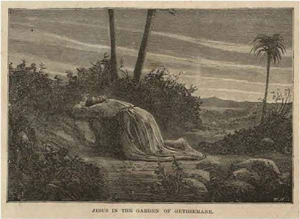
Discussion Question:
Tell of a circumstance in your life when you prayed deeply for your suffering or the suffering of your loved one to be removed and yet at the same time, also asked for God's will to be done and not your own? |
#331. Jesus Arrested
Matthew 26:47-56, Mark 14:43-53, Luke 22:47-53, John 18:2-12
-Immediately, while he was still speaking, Judas, one of the twelve, arrived; Judas, the universal symbol of betrayal for western culture, finally arrived on the scene.
-And with him there was a crowd with swords and clubs, from the chief priests, the scribes, and the elders. The crowd showed up for the “final solution” of getting rid of Jesus. Five days earlier, the crowd had been enthusiastic for Jesus, but this had all changed. We notice that the crowd is with the chief priests, scribes and elders, the real powers behind the plot to execute Jesus. The crowd had come under their spell.
-Now the betrayer had given them a sign, saying, ‘The one I will kiss is the man; arrest him and lead him away under guard.’ The word, “Judas,” and the word, “betrayer,” have become synonymous. Today, centuries later, we characterize a person as “Judas,” the one who betrays you. “You are a Judas” is one of the nastiest things that you can say about a person.
-So when he came, he went up to him at once and said, ‘Rabbi!’ and kissed him. Jesus betrayed Jesus with a kiss. Twice that fatal kiss is mentioned in this story. The kiss, which normally displays affection of love and friendship, now is used for just the opposite. What a pretense. Judas was pretending to be a friend but he was really the enemy of Jesus like no other.
-Jesus said to him, “Friend, why are you here?” (only Matthew).Only the Gospel of Matthew uses that piercing word, “friend.” Jesus asked, “Friend, why are you here?” Jesus immediately saw through the sham but still called Judas “friend.” In this moment of betrayal, Jesus demonstrated the same attitude he would demonstrate later from the cross when he said, “Father, forgive them, for they know not what they do.” Jesus possesses a divine magnanimity which is beyond human comprehension.
-Then they laid hands on him and arrested him.
-But one of those who stood near drew his sword and struck the slave of the high priest, cutting off his ear. All four gospels refer to this incident of the slave of the high priest having his ear cut off. This little incident and detail must have been important for all four gospels to record it. It must have been a shocking event for their senses, because each of the gospel authors remembers it.
- Then Simon Peter, who had a sword, drew it, struck the high priest’s slave, and cut off his right ear. The slave’s name was Malchus. (only John) Notice that John, the eyewitness, again gives us juicy details by naming both Simon Peter and Malchus. The ear is the “right” ear. Simon Peter is named and his impulsive action is consistent with his other impulsive actions e.g. “let’s built three booths” on the Mount of Transfiguration and his attempt to walk on water.
-Then Jesus said to him, ‘Put your sword back into its place; for all who take the sword will perish by the sword. (only Matthew) This is a truism: those who live by the sword will die by the sword. Those who live by violence will more likely die by violence. We know about the cycle of violence e.g. between the Israelis and the Palestinians. This portion of the incident is only recorded by Matthew but is profoundly true.
-Do you think that I cannot appeal to my Father, and he will at once send me more than twelve legions of angels? But how then would the Scriptures be fulfilled, which say it must happen in this way?’ (only Matthew) We recall Matthew’s Jewishness and his desire to have the actions of Jesus be substantiated from Old Testament prophecies.
-Then Jesus said to them, ‘Have you come out with swords and clubs to arrest me as though I were a bandit? Day after day I was with you in the temple teaching, and you did not arrest me. But let the scriptures be fulfilled.’ This is true. That is, the gospels have told us about Jesus teaching day after day in the temple and no one from the high priests had the courage to arrest Jesus in public.
-And he touched his ear and healed him. (only Luke) We recall that Luke was a physician and there are other instances in Luke’s gospel that emphasize the healing role of Jesus. Jesus miraculously healed the right ear of Malchus.
-All of them deserted him and fled. A few days earlier, the disciples were shouting their bravados that they would be faithful to Jesus under all circumstances, but in the crucial moment, they all deserted him and fled. The gospel authors are brutally accurate about the shortcomings and failures of the first disciples. The gospel authors do not idealize the disciples into super-heroes but show us their “clay feet.” We disciples are similar today.
-A certain young man was following him, wearing nothing but a linen cloth. They caught hold of him, 52but he left the linen cloth and ran off naked. We don’t know who this is, but the identity of this person has tantalized students of Scripture. Some scholars think that this person is John Mark, who is “the Mark” who authored the second gospel by his name. But there is no evidence that this is true.
Discussion Question:
For you, what is most important part of the story about the garden of Gethsemane? Why? |

 Back to Top Back to Top
|








